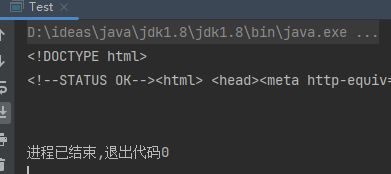Java爬虫入门——HttpClient,JSoup
一,网络爬虫介绍
爬虫也叫网络机器人,可以代替人工,自动的在网络上采集和处理信息。
爬虫包括数据采集,分析,存储三部
爬虫引入依赖
org.apache.httpcomponents
httpclient
4.5.14
二,入门程序
public static void main(String[] args) throws IOException {
//1,打开浏览器,创建HttpClient对象
CloseableHttpClient client = HttpClients.createDefault();
//2,输入网址,发起HttpGet请求
HttpGet httpGet = new HttpGet("http://www.baidu.cn");
//3,按回车,发起请求,使用Httpclient对象发起请求
CloseableHttpResponse response = client.execute(httpGet);
//4,解析响应,获取数据
if (response.getStatusLine().getStatusCode() == 200){//获取响应数据的状态码
HttpEntity entity = response.getEntity();//获取响应体
String content = EntityUtils.toString(entity,"utf8");//获取静态页面
System.out.println(content);
}获取到百度首页的前端页面
三,HttpClient请求
一),使用Http协议客户端HttpClient这个技术,抓取网页数据。
二),Get请求
1,不带参数的get请求,获取静态页面的行数
public static void main(String[] args) throws IOException {
//创建HttpGet对象
HttpGet httpGet = new HttpGet("http://www.itcast.com");
//创建HttpClient对象
CloseableHttpClient httpClient = HttpClients.createDefault();
CloseableHttpResponse response = null;
try {
//使用HttpClient对象发起请求,获取response
response = httpClient.execute(httpGet);
//解析响应
if (response.getStatusLine().getStatusCode() == 200){
String content = EntityUtils.toString(response.getEntity(), "utf8");
System.out.println(content.length());
}
} catch (IOException e) {
}finally {
response.close();
httpClient.close();
}
}2,带参数的HttpGet请求
public static void main(String[] args) throws Exception {
//建立URIBuilder请求的路径
URIBuilder uriBuilder = new URIBuilder("http://www.baidu.com/s");
uriBuilder.setParameter("wd","狂飙")
.setParameter("rsv_spt","1");//设置参数
//建立该路径下的Get请求
HttpGet httpGet = new HttpGet(uriBuilder.build());
System.out.println("发起请求的信息:" + httpGet);
//创建HttpClient对象
CloseableHttpClient httpClient = HttpClients.createDefault();
CloseableHttpResponse response = null;
try {
//使用HttpClient对象发起请求,获取response
response = httpClient.execute(httpGet);
System.out.println("响应状态码"+response.getStatusLine().getStatusCode());
//解析响应
if (response.getStatusLine().getStatusCode() == 200){
String content = EntityUtils.toString(response.getEntity(), "utf8");
System.out.println("响应体长度:" + content.length());
}
} catch (IOException e) {
}finally {
response.close();
httpClient.close();
}
}三),Post请求
1,不带参数的HttpPost请求
public static void main(String[] args) {
//创建HttpClient对象
CloseableHttpClient httpClient = HttpClients.createDefault();
//创建HttpPost对象
HttpPost httpPost = new HttpPost("http://www.baidu.com");
System.out.println("发起请求信息"+httpPost);
CloseableHttpResponse response = null;
//获取响应
try {
response = httpClient.execute(httpPost);
System.out.println("响应状态码:" + response.getStatusLine().getStatusCode());
String content = EntityUtils.toString(response.getEntity());
System.out.println("响应数据长度:"+content.length());
} catch (IOException e) {
throw new RuntimeException(e);
}finally {
try {
httpClient.close();
} catch (IOException e) {
throw new RuntimeException(e);
}
}
}2,带参数的HttpPost请求
public static void main(String[] args) throws UnsupportedEncodingException {
//创建HttpClient对象
CloseableHttpClient httpClient = HttpClients.createDefault();
//创建HttpPost对象
HttpPost httpPost = new HttpPost("http://www.baidu.com");
System.out.println("发起请求信息"+httpPost);
//设置List集合,用来存放请求的参数
List params = new ArrayList<>();
//添加请求参数
params.add(new BasicNameValuePair("wd","狂飙"));
//创建Entity对象,构造方法中,一个是请求参数集合,一个是字符集编码
UrlEncodedFormEntity formEntity = new UrlEncodedFormEntity(params,"utf8");
//设置表单的Entity对象到Post请求中
httpPost.setEntity(formEntity);
CloseableHttpResponse response = null;
//获取响应
try {
response = httpClient.execute(httpPost);
System.out.println("响应状态码:" + response.getStatusLine().getStatusCode());
String content = EntityUtils.toString(response.getEntity());
System.out.println("响应数据长度:"+content.length());
} catch (IOException e) {
throw new RuntimeException(e);
}finally {
try {
httpClient.close();
} catch (IOException e) {
throw new RuntimeException(e);
}
}
} 四,HttpClient连接池
public static void main(String[] args) {
//创建httpClient连接池管理对象
PoolingHttpClientConnectionManager manager = new PoolingHttpClientConnectionManager();
//设置连接池最大连接数量
manager.setMaxTotal(100);
//设置本机访问每个url时,最多分配10个httpClient对象访问
manager.setDefaultMaxPerRoute(10);
doGet(manager);
doGet(manager);
}
public static void doGet(PoolingHttpClientConnectionManager manager) {
//从连接池中获取httpClient对象
CloseableHttpClient httpClient = HttpClients.custom().setConnectionManager(manager).build();
CloseableHttpResponse response = null;
try {
//设置请求路径和参数
URIBuilder uriBuilder = new URIBuilder("http://www.baidu.com/s");
uriBuilder.setParameter("wd","狂飙");
//创建HttpGet请求
HttpGet httpGet = new HttpGet(uriBuilder.build());
System.out.println("请求头:" + httpGet);
//发起请求
response = httpClient.execute(httpGet);
//解析请求
if (response.getStatusLine().getStatusCode() == 200){
HttpEntity entity = response.getEntity();
String content = EntityUtils.toString(entity);
System.out.println("响应数据的长度:"+content.length());
}
}catch (Exception w){
}finally {
try {
response.close();
} catch (IOException e) {
throw new RuntimeException(e);
}
//httpClient不能手动关闭,因为交给了连接管理
}
}五,请求参数
因为网络或者服务器的原因,需要设置一些参数,确保访问快速,正常!
//创建HttpGet对象
HttpGet httpGet = new HttpGet("http://www.baidu.com");
//设置HttpClient请求参数
RequestConfig config = RequestConfig.custom().setConnectTimeout(1000)//设置连接创建最大时间
.setConnectionRequestTimeout(1000)//设置获取连接最大时间,单位ms
.setSocketTimeout(10 * 1000) //设置数据传输最大时间
.build();
httpGet.setConfig(config);//将配置设置到get请求中六,Jsoup
Jsoup是专门解析html的技术,是一款Java的html解析器
可以直接解析url地址、Html文本内容,提供了非常省力的API,课通过DOM,CSS以及类似于JQuery的操作方法来取出和操作数据。
主要功能:
1,从一个url,文件或字符串中解析html
2,使用DOM,CSS选择器来查找,取出数据
3,可操作HTML元素,熟悉,文本;
Jsoup依赖:
org.jsoup
jsoup
1.10.2
引入IO工具类依赖
commons-io
commons-io
2.6
引入字符串工具类
org.apache.commons
commons-lang3
3.7
一),Jsoup解析url
@Test
public void testURL() throws Exception{
//Jsoup解析url地址,获取百度首页标题,超时时间1000ms
Document document = Jsoup.parse(new URL("http://www.baidu.com"), 1000);
String title = document.getElementsByTag("title").first().text();
System.out.println(title);
}二),Jsoup解析字符串
@Test
public void testString() throws Exception{
//将文件转换成字符串
String fileToString = FileUtils.readFileToString(new File(""), "utf8");
//使用Jsoup解析字符串
Document document = Jsoup.parse(fileToString);
//获取title标签
Element title = document.getElementsByTag("title").first();
System.out.println(title.text());
}三),Jsoup解析文件
@Test
public void testFile() throws Exception{
Document document = Jsoup.parse(new File(""), "utf8");
Element title = document.getElementsByTag("title").first();
System.out.println(title.text());
}四),使用dom方式遍历文档
@Test
public void testDOM() throws Exception{
//获取dom对象
Document document = Jsoup.parse("http://www.baidu.com/");
//解析
Elements title = document.getElementsByTag("title");//通过标签获取元素
Element elementById = document.getElementById("s_menu_mine");//通过id获取元素
document.getElementsByAttribute("属性名");//通过属性获取元素
document.getElementsByAttributeValue("href","value");
document.getElementsByClass("类名");//通过类获取元素
}五),从元素中获取数据
@Test
public void testData() throws Exception{
Document document = Jsoup.parse("http://www.baidu.com/");
Element element = document.getElementById("kw");
element.id();//获取元素id
element.text();//获取文本内容
element.className();//获取元素的class
element.attributes();//从元素中获取所有属性的值
element.attr("class");//从元素获取属性的值
element.select("span");//通过搜索span标签获取Element
element.select("#id");//通过搜索id标签获取Element
element.select(".class");//通过搜索class标签获取Element
element.select("[name]");//通过搜索属性获取Element
element.select("[class=class_a]");//通过属性的值获取Element
}


